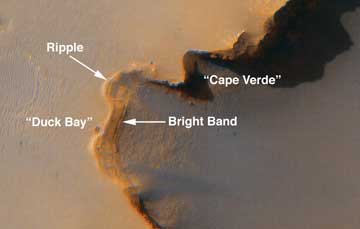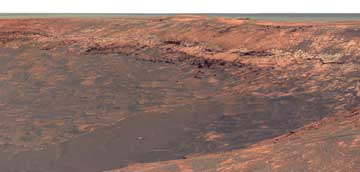|
NEWS NOTES — NEWS
Planetary geology
More on Mars
 NASA/JPL/University of Arizona |
| In mid-July, NASA’s Mars rover Opportunity rolled into Victoria Crater at “Duck Bay,” shown here. |
NASA’s Mars rover team took a collective deep breath as the robotic explorer Opportunity prepared to descend into the red planet’s giant Victoria Crater in mid-July. The descent is risky for the aging rover, which might not be able to climb back out. Opportunity has spent nine months circling the crater as researchers searched for the best point of entry. They finally settled on an alcove called Duck Bay with a relatively gentle grade of 15 to 20 degrees. The team says the risks are worth it: They hope that sediment in the crater’s depths will provide more evidence about ancient environments on Mars, and the crater’s steep walls will hold more clues to the planet’s past.
The last few months have held many new discoveries on Mars, including new images of the red planet’s landslides, caves and polar geysers from the Mars Reconnaissance Orbiter’s High Resolution Imaging Science Experiment, which are giving scientists a closer look at the red planet than ever before. Here is the latest on the Mars missions.
Shifting ocean shorelines
Mineral and photographic evidence suggests that Mars was once covered by ancient
oceans, lost long ago when the planet’s magnetic field shut off and the
solar wind blew away its atmosphere. What appear to be the ancient shorelines
of those oceans, however, are at much higher elevations — several kilometers
— than could be accounted for by any sea-level changes known to have occurred
in Earth’s history. Geophysicist Taylor Perron of Harvard University in
Cambridge, Mass., and colleagues think they have solved the mystery: Rotating
planets bulge at the equator, causing large differences in elevation. If a dramatic
event altered the elastic lithosphere — such as the creation of Mars’
Olympus Mons, the largest mountain in the solar system — it could have
shifted the poles temporarily, deforming the lithosphere and explaining the
elevation difference, they wrote June 14 in Nature.
 NASA/JPL-Caltech/Cornell |
| An up-close view of Duck Bay shows its gradual slope of 15 to 20 degrees and exposed bedrock. Opportunity will investigate the soils within the crater, looking for evidence of the ancient environment on Mars, and will study the crater’s walls, including a bright outcrop that scientists say shows the height of the ground surface prior to the impact that formed the crater. |
Mars’ liquid core
Mars’ core is completely molten, according to new research published June
1 in Science using estimated temperatures and pressures in the planet’s
interior. That could explain why Mars’ magnetic field shut off 4 billion
years ago, as a solid inner core is a necessary ingredient to make a magnetic
field-producing dynamo like Earth’s, say geochemist Andrew Stewart of the
Swiss Federal Institute of Technology in Zurich, Switzerland, and colleagues.
The discovery could also mean that Mars’ own magnetic field may someday
regenerate, if small amounts of crystallization within the core stir up enough
energy to turn its dynamo back on.
ESA wants you
The European Space Agency (ESA) announced in June that it is looking for a few
good candidates to take a wild ride: a 520-day simulated trip to Mars during
2008 and 2009, complete with extreme isolation, close quarters and International
Space Station-style food. The chosen 12 men and women will follow the profile
of a real Mars mission, including an exploration phase on the surface of the
planet — all within a special facility in Moscow. From these simulated
conditions, ESA hopes to learn more about human health and behavior under the
extreme stresses of such a mission.

 Subscribe
Subscribe


